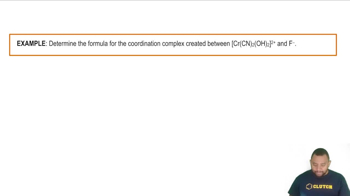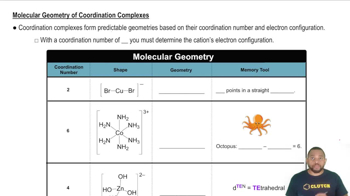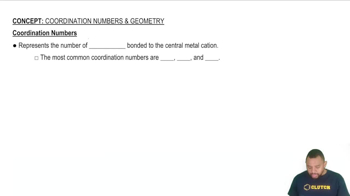Identify the oxidation state of the metal in each of the following compounds.
(a) (NH4)3[RhCl6]
(b) [Cr(NH3)4(SCN)2]Br
(c) [Cu(en)2]SO4
(d) Na2[Mn(EDTA)]
 Verified step by step guidance
Verified step by step guidance



Identify the oxidation state of the metal in each of the following compounds.
(a) (NH4)3[RhCl6]
(b) [Cr(NH3)4(SCN)2]Br
(c) [Cu(en)2]SO4
(d) Na2[Mn(EDTA)]
What is the formula, including the charge, for each of the following complexes?
(a) An iridium(III) complex with three ammonia and three chloride ligands
(b) A chromium(III) complex with two water and two oxalate ligands
(c) A platinum(IV) complex with two ethylenediamine and two thiocyanate ligands
What is the formula, including the charge, for each of the following complexes?
(a) An iron(III) complex with six water ligands
(b) A nickel(II) complex with two ethylenediamine and two bromide ligands
(c) A platinum(II) complex with two chloride and two ammonia ligands
Draw the structure of the following complexes. What are the oxidation state, coordination number, and coordination geometry of the metal in each?
(a) Na[Au(CN)2]
Draw the structure of the following complexes. What are the oxidation state, coordination number, and coordination geometry of the metal in each?
(b) [Cr(NH3)2(C2O4)2]NO2